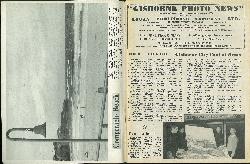3
Our Cover Gisborne City Coat of Arms
Our cover this month is the proposed Gisborne full Achievement of Arms. The Patent of Arms should be received by the City Council about three months after it has decided upon the motto.
The coat of arms is the result of two years voluntary work by Messrs H. H. Wale, G. T. Griffiths, W. H. Way and J. C. Burland. They were responsible for the design, and the raising of $590 of the $690 required to finance the venture. The City Council met the balance.
A loose interpretation of the coat of arms is as follows. From the top:-
Crest The sun rising out of the clouds over Mt. Hikurangi. The Crest Wreath, Mantelling and Helmet are designs of the 13th century, the golden age of heraldry.
Supporters: The Lions Rampant are taken from the Coat of Arms of the Hon. William Gisborne after whom the city was named. The forked < unclear >s</ unclear > of the black lion represent the highways north and south, and the tail of the gold lion, the East Coast highway. Their dovetail collars symbolise the joining together of the European and Maori cultures.
Coat of Arms on the Silver Shield. Silver represents the harvest of the fishing industry, the Chief Wavy, or upper portion of the shield, the sea, and the Reversed Pallium in blue represents the rivers Taruheru and Waimata joining to form the Turanganui.
The Charges: H. M. Bark Endeavour on the sea. Two bulls heads representing the agricultural and pastoral, and the primary industries. Blue Mitre in the base recalls the early establishment of the Christian church in the district, with reference to the three bishops of the Waiapu Diocese who came from the Williams family.
Compartment: The prow and stern pieces of the two original Maori canoes, Horotu and Takitimu, are parted by a Koruru carved head. The head, which was taken from the original Turanga meeting house, is now in the Dominion Museum. The Koruru is the distinctive Turanga style of carving.
The whole coat of arms above the compartment represents the European history of Gisborne, which rests on the compartment itself, representing the early settlement of Turanganui-a-kiwa.
The reproduction of the coat of arms, in part or whole, can be undertaken only with the permission of the authorities, with whom the copyright rests.
The colours shown in the reproduction are approximates only.



